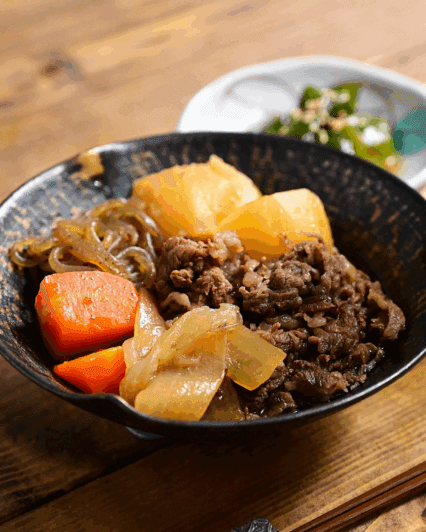While many global cuisines rely heavily on a variety of dried spices, Japanese cooking builds its depth using fermented ingredients and natural products from both land and sea. These ingredients—combined in thoughtful ways—unlock unique flavor profiles. The result is a cuisine that, although influenced by mainland Asia, has evolved into something entirely its own.
Below, we explore the essential sauces, broths, vinegars, and fermented ingredients that form the backbone of Japanese cooking.
Essential sauces of a Japanese kitchen
Much like the “mother sauces” in French cuisine, Japanese cooking has its own foundational sauces — and one very important broth — that are used in countless dishes and flavor combinations.
Two of the most important sauces are soy sauce and mirin. These two are the base for many marinades, glazes, and what you could call “daughter sauces,” like teriyaki and ponzu.
Soy Sauce (Shoyu)
Different varieties of soy sauce exist throughout East Asia, but Japanese soy sauces range from very dark to light, and include types like usukuchi (light), koikuchi (dark), saishikomi (twice-brewed), and tamari, which is often wheat-free. While it might be tempting to think “soy sauce is soy sauce,” tasting a few side-by-side reveals just how much flavor and nuance exists.
Because it’s fermented, soy sauce is deeply umami-rich and salty. While commonly used as a dipping sauce (as with sushi), its greater purpose is often as a flavor base, either alone or in combination with other ingredients. A little goes a long way—especially in dishes where it supports, rather than overpowers, other flavors.
Mirin
Mirin is a sweetened Japanese rice wine used exclusively for cooking. It’s not interchangeable with sake or rice vinegar, though it is often used alongside both. Where soy sauce is deeply savory, mirin adds balance with a touch of sweetness and acidity.
Mirin is especially useful when you want to add brightness to a dish. It’s a go-to when making glazes or marinades—frequently paired with soy sauce, sake, and sugar to create a tare sauce (more on that below).
Teriyaki & Tare
If there’s an unofficial official dish of Seattle, many would argue it’s teriyaki.
Whether teriyaki was “invented” in Seattle or simply evolved here is up for debate—but it’s fair to say that Japanese immigrants adapted traditional Japanese cooking techniques to local tastes, and the result has become a global favorite. The name teriyaki refers not only to the sauce but also to the cooking method: grilling or broiling with a glossy glaze.
Classic Japanese teriyaki sauce is a reduction of soy sauce, mirin, sake, and sugar. Sound familiar? It’s a tare—one of many sauces in Japanese cooking that use the same basic ingredients in slightly different ratios.
Tare, eel sauce (unagi no tare), and teriyaki are closely related. These sauces are used on grilled meats like yakitori (grilled skewered chicken), yakiniku (grilled meats), and unagi (grilled freshwater eel). They’re brushed over the food during cooking, caramelizing beautifully with each layer.
Then you’ve got okonomiyaki sauce and tonkatsu sauce, which lean even more into the sweet-salty umami spectrum, often drawing comparisons to Worcestershire sauce.
Ponzu
Ponzu is a citrus-based sauce that brings brightness and depth. It’s made by simmering a combination of mirin, rice vinegar, katsuobushi (bonito flakes), and kombu (sea kelp), then straining the mixture and finishing it with citrus juice—especially yuzu, sudachi, or lemon.
Technically, ponzu on its own doesn’t contain soy sauce. When it does, it becomes ponzu shoyu, the version most commonly found in stores and restaurants.
Ponzu shoyu is a balanced dipping sauce that pairs beautifully with dishes like gyoza, sashimi, shabu shabu, or any food that benefits from savoriness with a bright, clean finish.
Dashi: More than a broth
If you’re familiar with Japanese cooking, you know dashi.
Though often described as a broth, dashi is better thought of as a flavor base. Yes, it forms the foundation of soups like miso soup, oden, and other nabemono (hot pot) dishes, but it also adds umami to batters and doughs used in foods like okonomiyaki (savory pancakes), takoyaki (fried octopus fritters), tamagoyaki (Japanese-style omelette)
At its simplest, dashi is made by simmering kombu and katsuobushi in water, then straining. That’s it. There are more complex variations—some include dried shiitake mushrooms, small dried fish like niboshi, or use only kombu to make a vegetarian version—but the core idea remains the same.
You can make dashi from scratch (highly recommended for depth of flavor), or use instant dashi powder or granules for convenience.
Miso and all its complex glory
Like dashi, miso is a cornerstone of so many Japanese dishes beyond what it at first appears. Miso is a fermented soybean paste, often mixed with rice or barley. It comes in a range of flavors, colors, and strengths—generally grouped as:
- White miso (shiro miso): Mild, slightly sweet
- Red miso (aka miso): Bold, salty, deeply savory
- Yellow miso (shinshu miso): A middle ground—earthy and slightly tangy
Each miso has its own application, depending on the dish and your flavor goals.
Beyond the basic miso soup of dashi and miso, some styles of ramen include miso. It also can be used to make delicious marinades, salad dressings, miso butter, and even desserts. It’s versatile in non-Japanese cooking, too—try it in pasta sauces, roasted vegetables, or gravies for an umami boost.
When using miso in soups or broths, avoid boiling it too long or at high heat, which can dull its nuanced flavor. Add it toward the end of cooking for best results.
That said, high heat can work beautifully in other applications. A miso-marinated cod, for example, will caramelize in the oven, producing a deep, rich glaze.
Japanese vinegars and their balancing effects
Japanese cuisine uses vinegar to create balance and brightness.
Most common is rice vinegar—mild, slightly sweet, and lightly acidic. It’s famously used to season the rice in sushi, as the vinegared rice is what makes sushi sushi. But vinegar plays a role in many other dishes, from sunomono (vinegared cucumber salads) to pickles and dipping sauces.
You’ll also find black vinegar (made from brown rice or barley), which has a richer, more mellow profile and is often used in heartier dishes or dipping sauces. Less common, but still present in Japanese cuisine, are fruit vinegars—made from apples, persimmons, or grapes—often used in drinks or lighter dishes.
Putting it together
So much of Japanese cooking is about balancing complexity and the details of flavor to create a combination of tastes and texture that is genuinely unique.
The flavors of these sauces, broths, and concentrates all pair differently with other ingredients and, indeed, each other. In many ways, these different qualities and the combinations of sweet, savory, salty, bitter, and sour give you ingredients not just for recipes, but tools to help you explore balance and flavor layering.
Once you have shoyu, mirin, miso, vinegar, and dashi in your pantry, you’ll begin to understand how these elements interact—and how to create flavors that are both comforting and unexpected.





